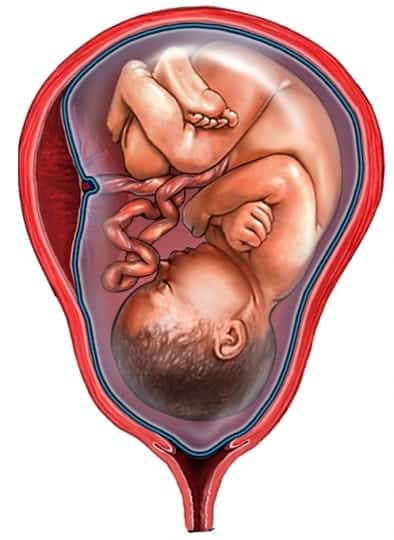
Table of Contents
Everyone is familiar with the term “when your water breaks“, this happens when the membrane that surrounds the baby ruptures. Now when in any pregnant woman the amniotic sac breaks way before the start of labor and the amniotic fluid flows out, it is known as the premature rupture of membranes (PROM).
If the membrane rupture occurs before the 37th week of pregnancy then it can be termed preterm rupture of membranes. In short, the premature rupture of membranes (PROM) is the rupture of fetal membranes before the mom’s gone into labor. The case of preterm premature rupture of membranes occurs in about 3% of pregnancies hence causing ⅓ of preterm births. It has been found that these types of cases occur frequently in twin pregnancies.
It is said that the earlier your membrane rupture occurs, the more serious the situation becomes for you and your baby. Your baby is ready to be born if your membrane ruptures and your pregnancy is past 37 weeks. But on the contrary, if a pregnant woman hasn’t crossed 37 weeks and the membrane ruptures, then the doctors will have to take a call on whether to deliver your baby immediately or try to continue the pregnancy. In most cases, the doctors choose early labor as there are chances that your baby will be prone to infection.
One must keep in mind that as soon as your water breaks rush to the hospital, as the diagnosis of the amniotic fluid must be done immediately, as women who deliver their kids within 24 hours of labor are less likely to get an infection as compared with the others. Women with health issues will be given extra care in the hospital too. The fetal membranes will be observed and taken care of. Once you reach the hospital, simple tests for identifying the ruptures are done to be sure.
What are The Symptoms of Premature Rupture of Membranes?
If you have fluids leaking from your vagina, then this is a sign that this is the premature rupture of membranes. The fluid will trickle down slowly, do not mistake the fluid for urine. To make sure, do smell the amniotic fluid, if the amniotic fluid doesn’t have the smell of urine, then take the sign of prom.
Use a pad or tissue to absorb the fluid. There are various other signs to identify premature rupture of membranes. Pelvic pressure, bleeding vagina, and vaginal discharge are a few of these signs.
1. Diagnosing Premature Rupture of Membranes
If you doubt that your water has broken, then immediately get in touch with your doctor. They will examine your vaginal fluid and will confirm if it is a PROM or preterm premature rupture of membranes.
The diagnosis of the premature rupture is done by analyzing the vaginal secretions. They will check for the presence of amniotic fluid. These tests are done in order to look for characteristics that are usually found only in amniotic fluid. Raw vaginal discharge has a high chance of being contaminated with blood.
Your doctor will collect the fluid from the vagina using a speculum. The speculum is inserted inside the vagina spreading the walls and directly collecting the fluid.
2. pH Test
The test of premature rupture of membranes is done using pH test too. They collect samples from the vagina and send them for testing. Let us tell you that the fluid of a normal vagina has a pH between 4.5 and 6.0. The pH of Amniotic fluid is higher and is usually 7.1 to 7.3. So, if you find the vaginal fluid to have higher pH, then it means that there is a premature rupture.
3. Nitrazine Test
Another method to detect the rupture of the membranes is by doing the nitrazine test. For the test, a drop of fluid obtained from the vagina is dropped into a paper strip having nitrazine dye. If the strip changes its color to blue then it means the pH is greater than 6.0, which means it’s more likely the membranes are ruptured.
However, these test results are not always considered right, as there are chances of the test producing a false result. The presence of blood or infection will cause the test to show a higher pH level. Not only this, but recent vaginal intercourse will also give false results as semen by nature has high pH.
4. Ferning
If the premature rupture of membranes occurs then the fluid can get mixed with estrogen and will form a fern-like pattern when seen through a microscope. This happens due to the crystallization of salt. And this is how this method of testing is done.
Other than the above-mentioned tests, there are other means to detect the rupture of the membranes. There is a dye test that injects the dye into the amniotic sac where the amniotic fluid is found. If the premature rupture of membranes has occurred then colored fluid will be found in the vagina within 30 minutes.
Then some tests look for chemicals in amniotic fluid but not in vaginal fluids. The presence of substances like prolactin, alpha-fetoprotein, glucose, and diamine oxidase in higher levels means premature rupture.
Are There Complications to PROM?
Infection is the biggest risk of premature rupture of membranes. As soon as one learns of the infection in the uterus, the baby must be delivered immediately, as it will cause serious problems to the baby and the pregnant woman. Preterm delivery is the biggest risk in preterm premature rupture of membranes, as it increases a lot of complications for the kid.
Due to the rupture of membranes (PROM), the baby might have learning disabilities and neurological and even respiratory distress syndrome. The umbilical cord can also get damaged due to the absence of amniotic fluid. The worst-case scenario is when the umbilical cord gets compressed between the baby and the uterus causing even brain injuries or even death. This shows how important an amniotic fluid is.
Preterm PROM before the 24th week is rare. Well, what happens next depends on the stage of the pregnant woman. If the premature rupture of membranes occurred at the stage where the woman is 37 weeks and up with the pregnancy, then the doctor will immediately proceed to deliver the baby. This can happen spontaneously or by inducing some medications.
If the pregnant woman has neared near term then the doctor will suggest proceeding with the delivery, provided the hospital has neonatal care available. If the membranes rupture at preterm is less than 34 weeks, then the doctors will want to wait to induce labor. The doctors might even give antibiotics to avoid infection, some drugs to prevent contractions, and even steroid injections to speed up the baby’s development.
Let us tell you that both the pregnant woman and baby will be kept under observation and regular ultrasounds will be conducted to check for infections.
A Final Word: How Can I Prevent PROM?
Premature rupture of membranes cannot be prevented, but changing your lifestyle might reduce the risk. Smoking should be avoided, and also if one has a history of sexually transmitted disease then the risk of having premature rupture of membranes. Your doctor will even suggest you stop the intake of steroid medicines if any until it isn’t of utmost need as they aren’t considered good and might cause the premature rupture of membranes.
FAQS: Premature Rupture of Membranes
1. What color does Nitrazine paper turn with amniotic fluid?
2. How do you diagnose a premature rupture of the membrane?
3. At which time would a Nitrazine test be performed?
Sources:
Reviewed By:

Esha Chainani - Obstetrician and Gynaecologist
Dr. Esha Chainani is an Obstetrician, Gynaecologist, and laparoscopic surgeon who aims to break the stigma around women’s health by advocating an inclusive and open practice of obstetrics and gynecology and an author of several internationally published research papers and health articles in the media like the Swaddle.
She also founded Premaa, a non-profit to reduce maternal morbidity and eventual maternal mortality by providing lower-income pregnant women living in urban areas with cell phone access through an app that can feature an entire section about contraception as well for a whole gamut of reproductive health.
A panel for multiple health sessions including with the UN, USAID, BMC, gender at work, and multiple non-profit organisations, and is on the advisory panel of the South Indian medical students association.





